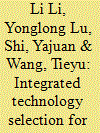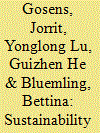|
|
|
Sort Order |
|
|
|
Items / Page
|
|
|
|
|
|
|
| Srl | Item |
| 1 |
ID:
118835


|
|
|
|
|
| Publication |
2013.
|
| Summary/Abstract |
Energy conservation and PAHs (polycyclic aromatic hydrocarbon) control are two challenges for the iron and steel industry, especially where the industry has developed at high speed. How to select appropriate technologies to improve energy efficiency and control pollution from PAHs simultaneously is encountered by both the researchers and the decision makers. This study sets up a framework on technology selection and combination which integrates technology assessment, multiple objective programming and scenario analysis. It can predict proper technology combination for different emission controls, energy conservation targets and desired levels of production. An iron and steel factory in Southwestern China is cited as a case. It is shown that stricter PAHs control will drive the transformation from process control technology to alternative smelting technology. In low PAHs limit, 25% energy reduction is a threshold. Before inclusion of a restraint on energy consumption at 25% reduction, PAHs emission is the key limiting factor for the technology selection; while after inclusion of this restraint, energy consumption becomes the key limiting factor. The desired level of production will also influence the technology selection. This study can help decision makers to select appropriate technologies to meet the PAHs control objectives and energy conservation strategies in energy-intensive industries.
|
|
|
|
|
|
|
|
|
|
|
|
|
|
|
|
| 2 |
ID:
128360


|
|
|
|
|
| Publication |
2014.
|
| Summary/Abstract |
Emerging economies are increasingly contributing to global innovation, including clean-tech innovation. The development of China's wind power sector has often been used to illustrate this point. China's domestic wind power market is the largest in the world and is largely supplied by domestic manufacturers. Competition for market share in the domestic market may pressure firms to innovate, which consecutively improves prospects for global expansion. This paper reviews developments in China's domestic wind turbine market using the Technological Innovation System framework. We analyze the pressure to innovate arising from market competition and assess the prospects for global expansion of Chinese wind turbine manufacturers. We conclude that domestic customers are not pressured or incentivized to perform with respect to power output, such that turbine manufacturers are not pressured to perform with respect to turbine efficiency or maintenance needs. Pressure to innovate is further reduced by formalizing connections between wind farm developers and turbine manufacturers. Chinese turbine manufacturers cannot yet compete with leading global brands in technological leadership. The prospects for exports are improved, however, by the preferential supply of project financing from institutional investors, such as the China Development Bank, from Chinese utilities that seek global expansion and from the manufacturers themselves.
|
|
|
|
|
|
|
|
|
|
|
|
|
|
|
|
| 3 |
ID:
118842


|
|
|
|
|
| Publication |
2013.
|
| Summary/Abstract |
Households in rural China rely heavily on low quality fuels which results in reduced quality of life and environmental degradation. This study assesses the comparative contribution of household scale biogas installations to the broad set of sustainability objectives in the Chinese biogas policy framework, which targets household budget, fuel collection workload, forest degradation, indoor air quality and health, renewable energy supply, and climate change. A household survey was used to determine how biogas affected consumption levels of crop residues, fuel wood, coal, LPG, and electricity. Biogas users were found to reduce consumption of biomass fuels but not coal. Although LPG is not a highly commonly used fuel in rural China, biogas users nearly cease to use it altogether. A big reduction in fuel wood consumption results in strongly reduced workload and forest degradation. Although household scale biogas has alleviated all sustainability issues targeted by Chinese policies, low quality fuel use remains abundant, even in households using biogas. Continued promotion of the construction of biogas installations is advisable, but additional policies are needed to ensure higher quality heating energy supply and cleaner uses of biomass fuels.
|
|
|
|
|
|
|
|
|
|
|
|
|
|
|
|
|
|
|
|
|